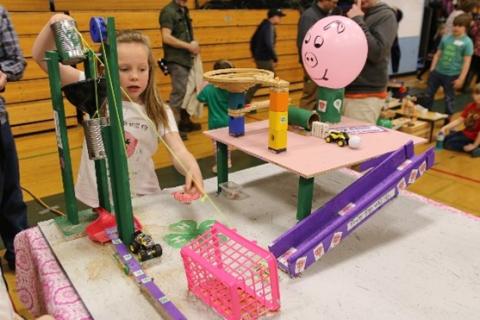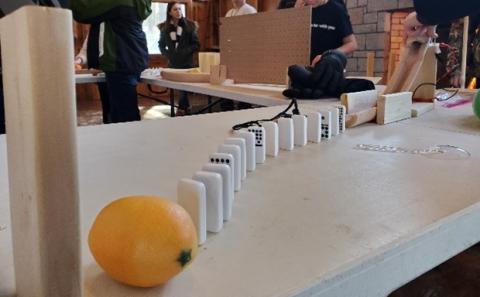

Chain reactions and Rube Goldberg Machines are fun, whimsical contraptions made up of a set of connected events linked together, each one triggering the next forming a series of reactions. Imagine marbles rolling down ramps, toppling dominoes, swinging pendulums, moving levers and falling objects. Inspired by artists such as Rube Goldberg and Bruno Munari, chain reactions are a fun way to learn about cause and effect, simple machines, and the energy of motion. Chain reactions celebrate STEaM by encouraging creativity, clever thinking, art, and engineering by building these complex inventions that complete simple tasks.
4-H youth, clubs, families and other groups are invited every year to build a chain reaction machine to share them at the 4-H Clover Corner every spring.
Getting Started Building Chain Reactions
The best way to get started making chain reactions is all about just diving in, but getting started can often a challenge. Here are a few pointers.
Inspiration and Examples
- Start with the end in mind. What is your end goal? For example, make a machine that will feed a pet, plant a seed or fill a cup with water. Once you have your end goal, make simple machines to do that task then work backwards using other “events” to trigger the ones you have made.
- Watch some videos of other chain reaction machines to get some ideas. Watching other chain reactions will help with ideas of possible materials to use, and ways to use them. Search YouTube using terms like "chain reactions" or "Rube Goldberg Machines" to get a selection of some really fun chain reaction videos. Some of our favorites include "Joseph's Machines", "the Lemonade Machine" and "OK Go, This Too Shall Pass".
- Make it Fun! - Follow a theme or tell a story. The 4-H Chain Reaction Challenge has a new theme each year.
- Find fun and crazy ways to include normal, everyday objects. Use stuffed animals to drive a car, or roll a whisk down a ramp. Use everyday objects in funny and weird ways.
- Collecting materials - While almost anything can be used to make chain reactions, there are a few important things you may want to include.
- Balls, marbles and other things that roll.
- Ramps, made from boards, tubes, cardboard, books.
- Towers and other structures to build height.
- Wooden blocks, books and dominoes can be used for building or toppling over. (Be careful not to use too many dominoes, they topple easily and take time to set up.)
- Items that store energy like rubber bands, springs or pendulums
- Don't forget the decorations! Include items to decorate and make it personal.

Resources to Help Build Chain Reactions
Working With Youth – This is a one-page printable guide that offers Parents, 4-H volunteers and other educators some suggestions for working with and supporting youth to build chain reactions.
Simple Machines – Understanding simple machines is fundamental to knowing how things work and building Chain Reactions. This one-page guide illustrates the different components of simple machines and how they can be used in chain reactions.
Energy Transfer in Chain Reactions – A Chain reaction works by transferring energy from one object to another. This one-page guide explains some of the basic science of energy transfer and simple machines to help understand some of the science of building chain reactions.
Young Inventors Program – The Young Inventors Program works with 4-H to explore invention and chain reactions. They offer curriculum resources on building chain reactions/Rube Goldberg machines and the invention design process for upper elementary through middle school age youth. The Young Inventors Program hosts the annual Northern New England Invention Convention at UNH every spring. Questions about the Young Inventors Program or Northern New England Invention Convention can be sent to Tina White at tina.white@unh.edu.
The Tinkering Studio – The Exploratorium’s Tinkering Studio Website offers lots of great ideas and printable resources to help build chain reactions and other fun STEM projects.
Showcasing and Competing
4-H Chain Reaction Challenge – This annual 4-H challenge offers youth a chance to build their chain reaction design skills. Youth can showcase their chain reactions at the NH Farm, Forest and Garden Expo every year in the spring.
Northern New England Invention Convention – The capstone regional event for the Young Inventors' Program is the Northern New England Invention Convention. Students from New Hampshire, Massachusetts, and Vermont showcase their projects and celebrate together with the University of New Hampshire, board, and volunteers.
Rube Goldberg Machine Contest – Rube Goldberg Machine Contest is a fun way for youth to work together to build a crazy contraption while including fun elements that follow a theme. Teams of three to five youth ages 8 - 18 can enter in either Elementary (Gr. 3-5), Middle (Gr. 6-8) or High (Gr. 9-12) School divisions. Teams work together to build a Rube Goldberg machine to complete a simple task. The Rube Goldberg Machine Contest Finals are hosted every spring at Purdue University

